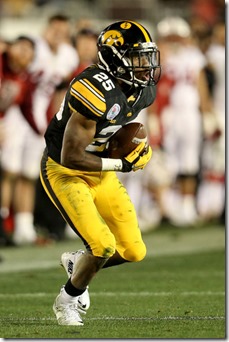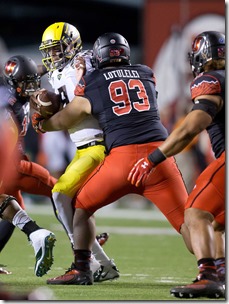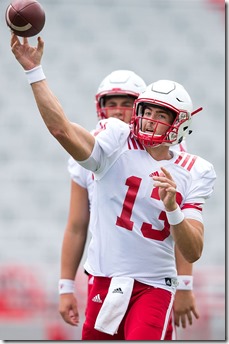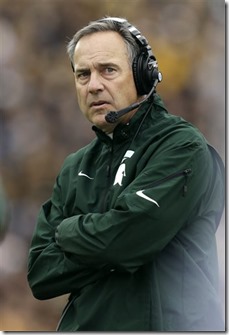For 2017, instead of previewing conferences division-by-division, I decided to preview the 64 Power Five teams individually, so I ranked them and counted down from the bottom.
I created a ranking system based heavily off of Bill Connelly’s S&P+ rankings: half of the ranking comes from the S&P rankings from the past five seasons among Power Five teams (1/3 of that number is 2016’s ranking; 1/3 is the average from 2014-2016, 1/3 is the average from 2012-2016); half comes from two component parts of his 2017 S&P+ projections, weighed evenly – recruiting impact and returning production – and ranked 1 through 64. The ranking itself skews towards emphasizing where the teams were according the 2016 S&P+ and there’s no subjectivity involved. I think it serves as a decent way to sequence these previews.
Previously: #64 Purdue, #63 Rutgers, #62 Kansas, #61 Illinois, #60 Boston College, #59 Virginia, #58 Vanderbilt, #57 Syracuse. #56 Maryland, #55 Arizona, #54 Wake Forest, #53 Duke, #52 Iowa State, #51 Texas Tech, #50 Missouri, #49 Oregon State. #48 Arizona State, #47 Cal, #46 Indiana, #45 Kentucky, #44 West Virginia, #43 South Carolina, #42 Washington State, #41 Northwestern.
(I didn’t include Notre Dame)
40. MINNESOTA![minn17 minn17]()
#4 Big Ten West, #8 Big Ten
9-4 (5-4) in 2016
It’s impossible to talk about Minnesota football without talking about how Tracy Claeys got fired after just one season as the head coach: he supported a player boycott in response to an investigation into appalling sexual assault allegations against members of the football team. The players wound up playing in the Holiday Bowl after threatening to sit it out; Claeys was fired after the New Year; some of the accused were expelled, some suspended, and some cleared.
PJ Fleck becomes the Gophers’ third head coach in three seasons – and it was a coup for the program to get a coaching prospect of his caliber who had been mentioned in connection with better jobs. Fleck and his energetic persona brought Western Michigan to unprecedented heights: the Broncos had an undefeated regular season in his fourth year in Kalamazoo and made the Cotton Bowl, built by a talent advantage he created by outrecruiting the rest of the MAC by a sizable margin.
He brought his offensive coordinator Kirk Ciarrocca, and while the Gophers will be moving to more of a spread attack, they’ll still be running the ball a ton: RBs Rodney Smith and Shannon Brooks totaled 378 carries a season ago and WMU ran the ball often with zone blocking schemes with Fleck and Ciarrocca in charge, setting up favorable coverages for their All-American WR Corey Davis. Minnesota will be choosing from a number of unproven quarterbacks and their only credible WR from last season is gone. If former Ohio State OL coach Ed Warinner works his magic with a cast of inexperienced if uninspiring linemen, Smith and Brooks will be leaned on all the more heavily. Minnesota does have one of the best kickers in the country in Emmitt Carpenter.
Minnesota got to a 9-4 record last season because of its defense – they won the scandal-marred bowl game over Washington State 17-12 in stereotypical Big Ten fashion. They have Steven Richardson back, a disruptive interior linemen who had seven sacks a season ago – potentially one of the best players in the Big Ten. Additionally, LBs Jonathan Celestin and Cody Poock as well as safeties Duke McGhee and Antoine Winfield Jr. make those above-average position groups. There are some holes though: cornerback is very unsettled and the defensive line outside of Richardson looks to be rather mediocre. If the defense can replicate what they did in 2016, Minnesota could challenge for the Big Ten West – but attrition makes that unlikely.
The schedule sets up nicely for Fleck, at least to start – the toughest game in the first half of the season is either @ Oregon State or home vs. Michigan State. The stretch run is brutal, with road trips to Iowa, Michigan, and Northwestern, as well as home games against Nebraska and Wisconsin – the Big Ten West frontrunner. It’s not hard to envision a team with a gaudy record, maybe even 7-0, faltering down the stretch; it’s also possible that a trip to Indianapolis could be at stake when they host the Badgers in the regular season finale.
Fleck will need to find a passing game – and the run game will have to be much better at keeping the offense on schedule. If he can cobble together a decent offense and keep the defense at a reasonably high level, they could surprise in his first year. That’s a lot to ask – they’ll probably finish near the middle of the West.
39. IOWA![iowa17 iowa17]()
#3 Big Ten West, #7 Big Ten
8-5 (6-3) in 2016
With Bob Stoops’s unexpected retirement, Kirk Ferentz is college football’s coach with the longest continuous tenure (as Bill Snyder briefly retired from his job at Kansas State). He’s entering his 19th season at Iowa; over his career, he’s posted a record of 135-92 – that would average out to 7.7 wins per 13-game season. Ferentz has had a few especially strong years – most recently in 2015, when they went undefeated through the regular season (before losing the Big Ten Championship Game and the Rose Bowl) – but most years, he’s squarely in 7-5 / 8-4 territory.
2016 was up-and-down: Iowa lost to North Dakota State (an FCS powerhouse, but still) in September and only scored 14 points in a win over Rutgers the following week; they were drubbed at Penn State and turned around to pull one of the biggest upsets of the season over then-undefeated Michigan on a last-second field goal; they crushed a 9-4 Nebraska team to close out the season and were blown out by Florida in the bowl game, 30-3.
Both halves of their RB platoon went for over 1,000 yards and had 10 rushing touchdowns each, and the passing game was mediocre, especially after the early-season injury to WR Matt VandeBerg (who took a medical redshirt). Iowa figures to rely heavily on its veteran OL – that’s particularly strong on the right side – and its RBs. LeShun Daniels is gone, but Akrum Wadley is back, and the latter showed more big-play potential than the former a year ago. The Hawkeyes also added Nevada transfer James Daniels, Nevada’s best player on offense in 2016, to the mix – whatever percentage of the carries he and Wadley each get remains to be seen, but they’ll run the ball so often that both will play prominent roles. Whoever wins the QB job (and whoever it is, they’ll be unproven) will be handing the ball off a lot.
The defense returns quite a few pieces, though they did lose star CB Desmond King and disruptive DT Jaleel Johnson. LB Josey Jewell is the best player on the defense – he’s an instinctive middle linebacker who’s stout against the run and had 124 tackles last season. The defensive line is mostly intact outside of Johnson, and Anthony Nelson has potential as a pass-rusher. The secondary looks shaky, as Brandon Snyder, an excellent safety, tore his ACL in the spring. Iowa’s defense will probably be pretty good – like it almost always is under Ferentz.
The QB situation and dearth of proven and healthy WRs are good reasons to be skeptical of Iowa’s chances of winning the West. Penn State and Ohio State come to play in Iowa City from the East in 2017, an unfortunate scheduling disadvantage. Ferentz promoted his son from OL coach to coordinator, a sign that things are unlikely to change much. Odds are that this will be a classic Ferentz team: strong running game, good defense, and seven or eight wins.
[33-38 after the JUMP]
38. COLORADO![colo17 colo17]()
#4 Pac-12 South, #7 Pac-12
10-4 (8-1) in 2016
From 2013 to 2015, Mike McIntyre’s first three seasons in Boulder, Colorado ranked 61st, 58th, and 61st in S&P+ among Power Five teams; last season’s breakthrough campaign saw them finish 17th– the best season the Buffs have had in well over a decade. Colorado was a power in the 90’s, but had fallen off immensely in recent years. McIntyre was hired away from San Jose State, where he’d taken the Spartans from one win in his first season to eleven in his third. Colorado was in dire circumstances when he arrived – former head coach Jon Embree complained of a stark lack of institutional support – but 2016’s 10-win, division championship season was a sign that Colorado may be back.
Their sole losses came against Michigan (in a game that was very close when starting QB Sefo Liufau was injured in the third quarter) and USC – both were on the road against teams who made New Year’s Six Bowl games, and Colorado was forced to use their backup quarterback in both games. They won games with offense (41-38 against Oregon) and defense (10-5 against Stanford in what had to be one of the ugliest games of the season), and won their last two games of the regular season against ranked teams – Washington State and Utah. Even though they were routed by Washington in the Pac-12 title game and Oklahoma State in the bowl game, it was an immense success as a whole.
Replicating it will be difficult. Liufau was a fantastic quarterback when healthy, but he’s gone; Steven Montez ascends to the starting job – he was awful when thrown into the fire against Michigan early in the season, but played well when given a week’s worth of prep as the starter in a couple other games. Montez has some mobility – though not as much as Liufau – and acquitted himself well for a redshirt freshman, particularly when he led the Buffs to that win over Oregon a week after the loss in Ann Arbor.
He’ll be surrounded by a ton of talent at the skill positions and four offensive linemen with significant starting experience. If Montez continues to develop, this could be one of the best offenses in the Pac-12. RB Phillip Lindsay is excellent: he ran for 1,252 yards and 16 touchdowns a year ago while also contributing 53 catches for 493 yards – Lindsay’s a smaller, more elusive back with surprising strength after contact. The entire receiving corps returns, headlined by Shay Fields and Devin Ross. Some of the linemen are moving around to different positions, but it’s a veteran group that should be just as good as last year’s unit, if not better.
The defense is the biggest reason why Colorado is likely to take a step back from last season; LB Rick Gamboa and safeties Ryan Moeller and Afolabi Laguda are back, but almost every other contributor is gone, as is former defensive coordinator Jim Leavitt, who took the job at Oregon. Colorado had two excellent corners, an impressive defensive line, and only allowed 21.7 points per game last season in a high-scoring conference – how much the unit regresses will be the biggest question for the Buffs this season.
The Pac-12 South’s overwhelming favorite is USC, but Colorado is right there in that second tier of teams in the division. The offense will be probably good enough to contend; the defense will probably take a big step back.
37. KANSAS STATE![ksu17 ksu17]()
#6 Big 12
9-4 (6-3) in 2016
Bill Snyder is synonymous with Kansas State football – he’s been the coach for a quarter century and has built one of college football’s historic doormats into a consistently respectable and stable program. He retired briefly and Ron Prince took over; after a few mediocre seasons for KSU, Snyder returned and has been successful. He’s gone 66-37 over eight seasons, including the 2012 season, which the Wildcats started 10-0. He stepped away from the program to receive cancer treatment, but at 77 going on 78 years old, he’s going to be patrolling the sidelines again in Manhattan this fall.
In 2016, Kansas State went 9-4 after a slow start, though all of their losses were against strong teams (and all but one came on the road). Narrow losses to West Virginia and Oklahoma State prevented them from having an even better season, but after having had a losing record the season before, an 8-4 regular season in which they won the games they should have and a solid bowl win in a de facto road environment against Texas A&M still represented significant improvement. Including A&M, they went 5-0 against teams from the state of Texas.
While the Wildcats may not have quite enough to take another step and challenge for the Big 12 title, they should still have a good offense. Snyder’s offenses have a type: low-tempo and run-heavy with a running quarterback and a play-action deep passing game. QB Jesse Ertz is a senior who has plenty of experience; he was KSU’s leading rusher with 1012 yards on 183 carries and 12 touchdowns – while his passing statistics were unimpressive, his contributions as what was basically Kansas State’s workhorse back were remarkable. Sophomore RB Alex Barnes ran for 7.9 yards per carry after getting more playing time late in the season; FB Winston Daniel had 12 touchdowns on less than 100 yards rushing. With most of the OL intact – including RT Dalton Risner, a first-team all-conference pick last season – KSU could have one of the strongest rushing attacks in the nation.
The defense is far less proven, with three of the top four tacklers from last season having departed. The defense improved as the season wore on a year ago, and Snyder’s teams typically have strong defenses, but they’ll be breaking in two new linebackers, lost their best pass-rusher by far, and will be relying on a JUCO transfer at free safety (Snyder famously loves recruiting from the junior college ranks). There’s some continuity in the rest of the secondary, which is headlined by CB DJ Reed. KSU’s bend-don’t break style is always tested by the Big 12’s high-octane offenses, and while their pass defense should be solid, there are enough questions in the front seven to think that they may take a step back this season.
KSU could be a dark horse in the Big 12, especially if they pull off an upset over Oklahoma at home in October (they lost to the Sooners by three touchdowns a year ago). With Ertz and most of what was a great ground game (5.2 yards per carry as a team in 2016) returning, they look to be a tough out for anyone, but their lack of big-play ability at WR makes them rather one-dimensional, and the defense needs to unearth some playmakers to be able to crack that top tier of teams in the conference.
36. UTAH![utah17 utah17]()
#3 Pac-12 South, #6 Pac-12
9-4 (5-4) in 2016
The biggest winner from the last round of conference realignment might have been Utah: they were promoted into the Pac-12 from the Mountain West, and even though they had a rough start to their time in the Power Five – going 8-5 in their first season then 5-7 twice in consecutive years – they’ve rounded into form as a solid Pac-12 South program. From 2014-2016, they’ve won at least nine games in each season, finished each season ranked, and barely missed out on a division title after losing two of their last three regular season games in 2015.
Whether the Utes overachieved slightly over that span is a fair question; a slight regression wouldn’t be unexpected, but Kyle Wittingham has established a baseline level of success that points to that slight dip after joining the Pac-12 as more of an aberration than these past three seasons. Wittingham is up there with the longest-tenured coaches in college football and once led the Utes to an undefeated season and Sugar Bowl win over Alabama in 2008. He’s built the program with defense and special teams first – in contrast from his predecessor, Urban Meyer – and has gotten by with average offenses in recent years.
Utah brought in a new offensive coordinator, a position that’s had frequent turnover under Wittingham (Meyer’s former defensive coordinator); next in line is former FCS Eastern Washington OC Troy Taylor, who had an explosive Air Raid attack at his last job. He’ll have a returning starting QB Troy Williams in Salt Lake City, but Williams only completed 53% of his passes, so he could be a poor fit – former Alabama backup Cooper Bateman is a one-year grad transfer rental who could win the job.
RB Joe Williams – the best player on Utah’s offense last season – is gone after rushing for 1,407 yards and 10 touchdowns. The new scheme would have deemphasized the run game regardless, but Williams’s departure means that they’ll be without their best offensie weapon. They only have one of their top four pass-catchers from a season ago (WR Raelon Singleon) – former Oregon WR Darren Carrington could be in line for a big role with Utah’s pass-heavy attack and plenty of snaps available at receiver. Only one starter returns on the line.
The strength of the defense will be up the middle with DTs Lowell Lotulelei, a first-team All-Pac 12 player, and Filipo Mokofisi, as well as LBs Sunia Tauteoli and Kavika Luafatasaga returning as starters. Box safety Chase Hansen was the team’s leading tackler a year ago, but he’s out with an injury. That leaves the secondary (in a de facto 4-2-5 look) with precious little experience against a schedule that will feature plenty of teams with great quarterback play and intimidating passing games.
The defense will likely be stout up front and, if they can manufacture a solid pass rush, they can mitigate the inexperience in the secondary – most expected contributors are older players who haven’t played much yet. Wittingham deserves the benefit of the doubt on that side of the ball at least, as they’ve had a consistent unit since joining the Pac-12. There are questions though, and the offense is unsettled as well. It would be a surprise to see the Utes challenge USC – the Pac-12 South favorite, by far – but it wouldn’t be a surprise to see them finish anywhere from second to fifth in a division without a clear hierarchy behind the Trojans.
35. GEORGIA TECH![gt17 gt17]()
#5 ACC Coastal, #9 ACC
9-4 (4-4) in 2016
Georgia Tech has one of the most unique programs in the Power Five, due to head coach Paul Johnson’s signature flexbone triple option offense, a military academy staple (Johnson was previously the coach at Navy), that’s only being used by one program in a power conference. Johnson’s entering his tenth season in Atlanta, and his tenure has been mostly successful: the Yellow Jackets won the ACC in 2009, appeared in two other conference championship games, and have posted a 71-48 record since Johnson replaced Chan Gailey.
In 2014, the Yellow Jackets barely lost to playoff-bound Florida State in the conference title game and then beat Mississippi State in the Orange Bowl; GT entered the next season with high expectations, but went just 3-9, by far Johnson’s worst season since arriving. They had much better luck in 2016, going 9-4 bookended with some inexplicable wins: a ridiculous fourth-down conversion on the game-winning drive helped them to a victory over Boston College in the season opener; they trailed Georgia late in the finale 27-14 before two late touchdown drives put them ahead by the winning point.
Tech’s offensive statistics didn’t really improve from 2015 to 2016 – and in fact, their points per game average dropped slightly – but they return most contributors from last year’s unit, except for multi-year starting quarterback Justin Thomas. Matthew Jordan played well in relief of Thomas last season (and actually led the Yellow Jackets to perhaps their biggest win of the season, an upset win over Coastal champion Virginia Tech on the road).
Sophomore fullback Dedrick Mills had the most carries on the team – mostly plunging into the line – and he headlines the skill position players; the receivers, who mostly block and occasionally catch long bombs down the field are back; injuries on the offensive line last season rendered it mostly ineffective in 2016, but it has significant depth for this season and should be better. Tech’s offense is tough to prepare for and even though most ACC coaches should be familiar with it by now, it’s radically different from what their opponents will see in almost every other game.
The defense returns eight starters and should be good again, particularly at preventing explosive plays from opposing offenses: they don’t exhibit much aggressiveness, preferring to keep things in front of them. The defensive line was perhaps the weakest position group on that side of the ball last season, and that may be the case again; on the other hand, the secondary was solid last season and returns all four starters, including leading tackler box safety Corey Griffin.
The season opener against Tennessee in Atlanta will be interesting – the Vols have underachieved but have recruited very well under Butch Jones, who’s now entering year five in Knoxville; Georgia Tech has overachieved with lesser-regarded recruits under Johnson. The Coastal is a division without a clear favorite, but any of five teams – including Georgia Tech – could theoretically make a run at the division title. The Yellow Jackets’ first three conference games are against some of the frontrunners – Pittsburgh and North Carolina at home, then @ Miami following a bye from each team so we’ll discover quickly whether they’re a contender or not.
34. NEBRASKA![neb17 neb17]()
#2 Big Ten West, #6 Big Ten
9-4 (6-3) in 2016
Bo Pelini lost exactly four games in each of his seven seasons as the head coach in Lincoln: it may be too simplistic to say that his 66-28 record wasn’t good enough, as he has a famously bellicose personality and a tape of him saying “fuck you, fans” once leaked during his tenure, but his firing indicated that Nebraska’s administration still believed they should have ambitions behind a perpetual 9-4 existence. They got rid of Pelini and brought in Mike Riley, who had built Oregon State into a consistent program, even if it had been sliding before he took the Nebraska job.
Riley lost seven games in 2015, his first season, though the Huskers did have terrible luck in close games (they also lost to Purdue, so they were definitely worse than Pelini’s teams). Nebraska started the 2016 season with a seven-game winning streak – beating a good Wyoming team easily, sneaking past an extremely overrated Oregon squad, and taking care of Northwestern on the road. They faced Wisconsin in Madison and lost in overtime despite staging a fourth-quarter comeback; they went to Columbus and were handed a 62-3 loss by Ohio State. Riley finished 9-4 after losses to Iowa and Tennessee to finish out the year.
If 9-4 isn’t good enough, it’s hard to see how the Huskers will be good enough in 2017. They lost longtime starting QB Tommy Armstrong, a limited passer who was a key part of some good rushing offenses, as well as their top RB and WR. The offense had a lot of young starters, most notably RG Tanner Farmer, a year ago, so they should improve, but questions abound on offense.
Perhaps that’s why Tulane transfer QB Tanner Lee has been so relentlessly hyped up this past offseason. Lee was unremarkable as a two-year starter as part of terrible teams in the CUSA – he threw for 3,601 over 19 starts and had two fewer interceptions (21) than touchdowns (23). Lee’s tall, has a big arm, and made some impressive throws in the spring game, but is completely unproven at the Power Five level and has a dearth of weapons to work with.
Riley hired former Brian Kelly DC (and UConn head coach) Bob Diaco as defensive coordinator, and he’ll be moving the Huskers – who had a decent if unremarkable defense (that got blown up by Ohio State) – to a 3-4 scheme. Nebraska returns six starters but loses its top three tacklers from a season ago; while there are potential space-eaters along the DL, a new LB corps will have to adjust to an increased role in the new defense. The secondary should be solid against the pass and they’ll need to be if Nebraska can’t find a pass-rusher.
The Big Ten West is divided into three tiers right now: 1) Wisconsin, 2) everybody else except for Purdue and Illinois, and 3) Purdue and Illinois. Nebraska may be the better than the rest of that second group, or they might be worse than that entire group – Iowa, Northwestern, and Minnesota. The Huskers face OSU at home and PSU on the road from the East, a brutal draw. If Lee fulfills lofty expectations, they could challenge the Badgers – they get them at home in October after an easy start to the schedule – but that’s a huge if and almost everything else points to Nebraska taking a step back from last season.
33. MICHIGAN STATE![msu17 msu17]()
#4 Big Ten East, #5 Big Ten
3-9 (1-8) in 2016
From 2013 to 2015, Michigan State was one of the best programs in the country: the Spartans won the Big Ten twice, played in three straight BCS/New Year’s Six bowl games, received a playoff bid, and posted a combined record of 36-5 (22-2 in conference) during that span. Sometime between their 2015 Big Ten championship game win over Iowa and their blowout loss to Alabama in the playoff semifinal, something snapped, sending the Spartans into a freefall down an elevator shaft.
It’s difficult to tell whether they’ve crashed into the ground yet. In 2016, Dantonio’s tenth season in East Lansing, State had the worst season of his tenure by far, going 3-9 and missing a bowl game for the first time since he became their head coach. A cast of veterans – headlined by QB Connor Cook – departed from that playoff team and a cast of veteran but inexperienced replacements were pretty much an unmitigated disaster. State lost a bunch of close games, and it was bizarre to see what had been one of the Big Ten’s standard-bearers in recent years lose to the likes of Indiana, Maryland, and Illinois. Closer than expected defeats at home to Michigan and Ohio State – including a near-upset of the Buckeyes – showed a little bit of fight, but still, a blowout win over Rutgers was the only thing preventing them from going winless against conference foes.
Amazingly, things could still get worse. There’s been a ridiculous amount of offseason roster attrition since the disastrous 2016 campaign ended, including players who probably would have been some of State’s best like LB Jon Reschke and WR Donnie Corley. Some of the players were dismissed, others transferred, and a lot of the most significant contributors from last season graduated, leaving MSU as one of the most inexperienced teams in all of college football. Had they been able to parlay their recent success into improved recruiting, the outlook would be marginally better, but they never did.
RB LJ Scott is one of the most underrated backs in the country and will be leaned on heavily, but the OL has little depth and could be a sieve. QB Brian Lewerke didn’t play much last season, though he did show some promise – and he has zero proven targets in the passing game. The DL is as pressed for functional players with requisite size as their compatriots on the other side of the trenches. The famous “No Fly Zone” secondary corps is a shell of its former self: it was flammable in 2016 and they’re going to be playing guys who weren’t good enough to displace the mediocre veterans last season.
Odds are that State’s luck in close games will regress to the mean somewhat, and two non-conference games against MAC foes could mean that they may reach a bowl game, but the outlook for a program so recently removed from excellence is almost unimaginably bleak. They could have a better record while getting worse. Dantonio has defied expectations throughout his career; he didn’t make any assistant coaching changes after a three-win season and the roster situation is quite dire for a Power Five program. Scott could drag them to an upset or two, but needless to say, it appears that if State’s time in the top tier of the conference is emphatically over.







